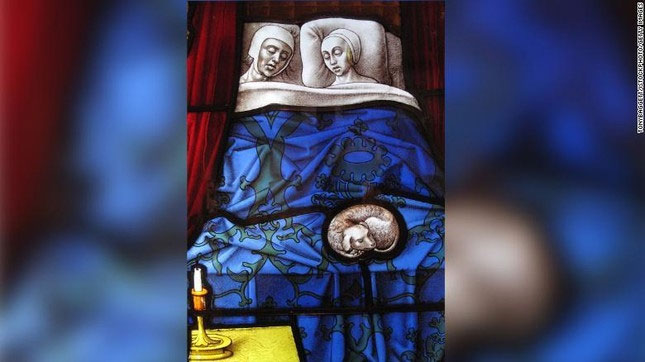How did our ancestors sleep and what do people with insomnia do?
Historian A.Roger Ekirch at Virginia Tech, USA studies about ancient sleep and thinks that sleep is a biological constant.
Yet while studying nightlife in pre-industrial Europe and America, he discovered the first evidence that many people used to sleep in segments - first sleep and first sleep. Monday with a break of a few hours to have sex, pray, eat, talk, and take medicine.
'This is a sleep pattern that is unknown in the modern world,' says Ekirch.
Two-phase sleep
Ekirch's follow-up book, "At Day's Close: Night in Times Past," unearthed more than 500 references to what has since come to be known as biphasic sleep. Ekirch has now found more than 2,000 references in dozens of languages and goes back in time to ancient Greece. His 2004 book will be republished next April.

Image of a couple sleeping on the glass door of the church.
Research shows that sleep training in adults prevents depression.
Sleeping through the night didn't really exist until just a few hundred years ago. It grew only with the spread of electric light and the Industrial Revolution, in the belief that sleep was a waste of time that could be spent doing better.
The myth of 8 hours sleep?
The first reference to biphasic sleep that Ekirch found was in a 1697 legal document from an itinerant court "Assizes" buried in a London recording office. The account of a 9-year-old girl named Jane Rowth mentions that her mother woke up from her "first sleep" to go out. The mother was later found dead.
Ekirch later found numerous references to "first" and "second" sleep in diaries, medical texts, literary works, and prayer books. A 16th-century French physician's manual advises couples that the best time to conceive is not at the end of a long day but "after the first sleep", when "they are more interested". and "make it better".
Lie on the right, then turn to the left
However, pre-industrial life was not the Halcyon era when our ancestors went through a well-rested and rejuvenated day, without insomnia or other sleep problems, easily syncing with night and day cycles, weather patterns and seasons. Sasha Handley, a history professor at the University of Manchester in the United Kingdom, who studies how families optimized their sleep in Great Britain, Ireland and the British American colonies between 1500 and 1750. know.
Handley says her research shows that, like today, sleep is linked to physical and mental health and is a subject of anxiety and phobia.
Doctors recommend sleeping on the right side first, and then on the left side in the second half of the night. Lying on the right side, perhaps during the first sleep, is thought to allow food to go to the stomach, where it is digested. Turn to the left, the cooler side, the steam escapes and distributes heat evenly throughout the body.
Insomnia
Russell Foster, a professor of biological neuroscience at the University of Oxford, has conducted sleep experiments that have shown that, when people are given the opportunity to sleep longer, their sleep can become biphas or even multiple phases.
However, Foster, who is also the director of Sir Jules Thorn Sleep and the Circadian Institute of Neuroscience at Oxford, suspects that it's a sleeping habit that can happen to everyone.
No one should impose a phased sleep regimen, he adds, especially if it reduces total sleep time. Interrupted sleep was considered less of a problem in the past, says Foster, but a good eight-hour sleep in modern times isn't always helpful.
Foster's research shows that, if we wake up at night, sleep is likely to return, if sleep isn't dominated by social media or other behavior that makes you more alert or triggers a stress response. straight.
Sleep experts recommend getting out of bed if you can't get back to sleep and engaging in a relaxing activity in low light.
- How to lose sleep?
- Decode sleep and sleepless nights
- The cure for insomnia is much simpler than we thought
- The secret to a good night's sleep
- The danger of insomnia
- 16 natural remedies for insomnia
- Terrible things will happen when you don't sleep!
- Why the more insomnia, the more difficult you sleep?
- High age is good for sleep
- One more type of food helps to prevent insomnia
- Insomnia is causing billions of dollars in damage
- One of the leading causes of insomnia in the city is ...
 The truth about the mysterious red-haired giant at Lovelock Cave
The truth about the mysterious red-haired giant at Lovelock Cave Inunaki Tunnel: The haunted road leading into Japan's 'village of death'
Inunaki Tunnel: The haunted road leading into Japan's 'village of death' The mystery of the phenomenon of human reflection before dying
The mystery of the phenomenon of human reflection before dying 6 mysterious phenomena, although science has been developed for a long time, still cannot be answered
6 mysterious phenomena, although science has been developed for a long time, still cannot be answered Why do women sleep less and wake up more than men?
Why do women sleep less and wake up more than men?  Top 5 extremely common habits before bed, seemingly normal but have unexpected harmful effects
Top 5 extremely common habits before bed, seemingly normal but have unexpected harmful effects  Strange woman who hasn't slept for... 40 years
Strange woman who hasn't slept for... 40 years  Why does the sound of running water help us sleep better?
Why does the sound of running water help us sleep better?  Discover the political factor that keeps you up at night
Discover the political factor that keeps you up at night  Seemingly harmless habits that ruin your sleep
Seemingly harmless habits that ruin your sleep 